2039
25th anniversary of #Ferguson
The St. Louis region's complicated history with race dates back to 1820, when the Missouri Compromise admitted Missouri to the Union as a slave state. Though the law now says all citizens are equal, the data says otherwise. The outcome disparities are especially glaring when it comes to education. Today, nearly 200 years after the Missouri Compromise, what has been compromised for children of color in Missouri is an equal chance for a quality education.
The #EducationUncompromised timeline traces key historical decisions that have impacted today’s educational landscape. The timeline was first presented on paper on the wall at a series of public events, where attendees answered questions and added comments and suggestions via marker and Post-It notes. Key milestones, as determined by public input, St. Louis-area education scholars, and the Forward Through Ferguson team, are presented here.
25th anniversary of #Ferguson
Learn more
St. Louis Post-Dispatch: Voluntary deseg program to close for new students in 2024
Ten years after SLPS loses accreditation, Missouri Board of Education reaccredits district.
Learn more
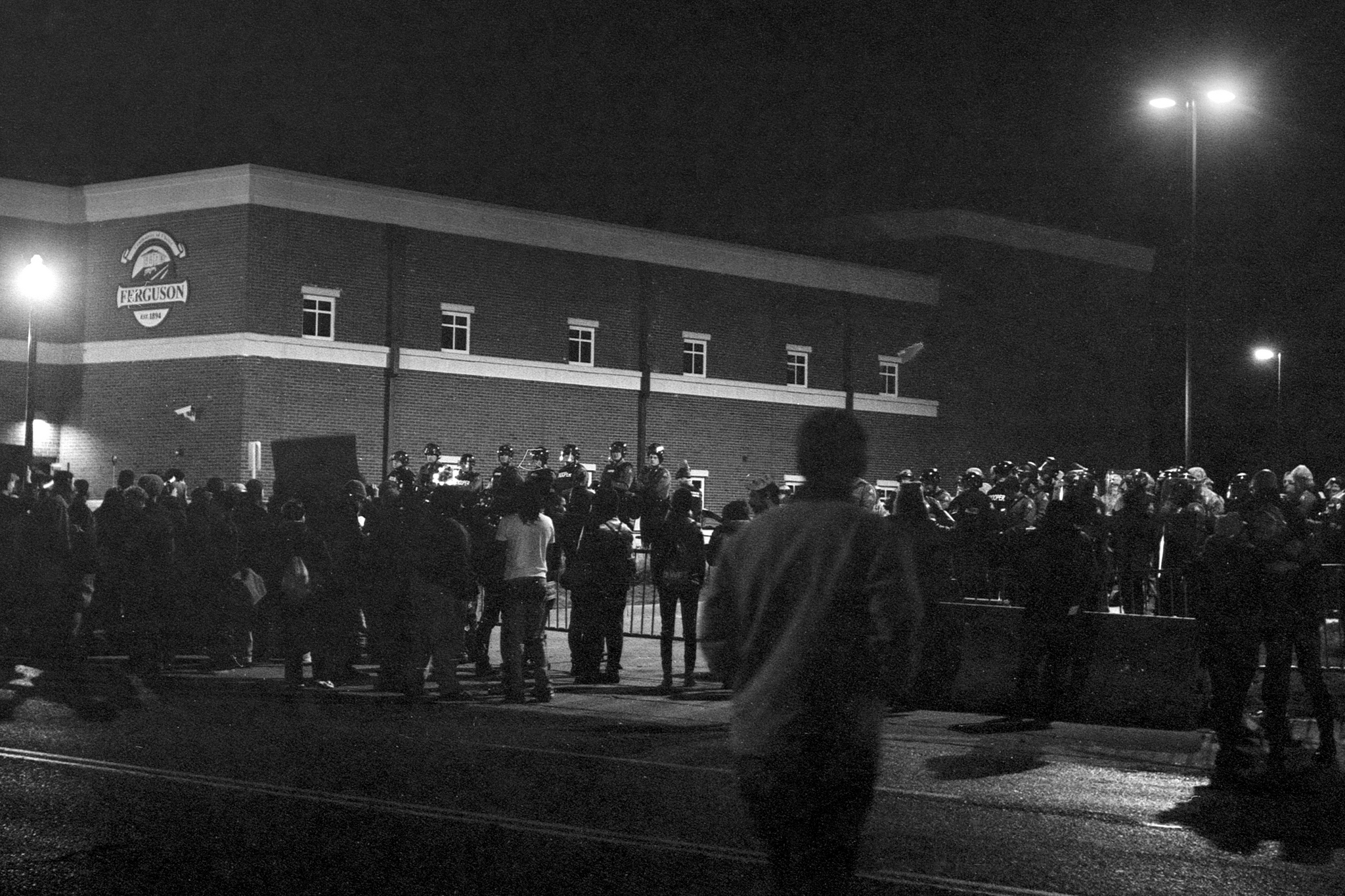
Image Credit: Flickr User – Mike Tigas
Learn more
St. Louis Post-Dsipatch: Michael Brown remembered as a ‘gentle giant’
Facing 55% graduation rate, among other shortcomings, State of Missouri takes control of St. Louis’s public schools.
Learn more
Students do not have right to counsel in responding to charges at school, as requiring schools to impose “even truncated trial-type procedures” would be too costly and onerous for administrators.
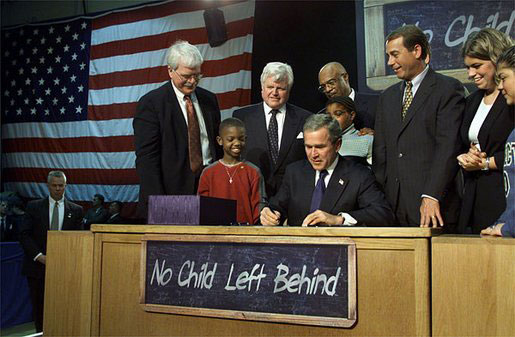
Image Credit: White House photo by Paul Morse.
Increased federal government’s role in guaranteeing quality of public education for all children. Emphasis on increased funding for poor school districts, higher achievement for poor and minority students, new accountability measures for student progress came hand-in-hand with dramatic expansion of standardized testing (i.e., yearly reading and math testing for students grades 3 through 8).
Learn more
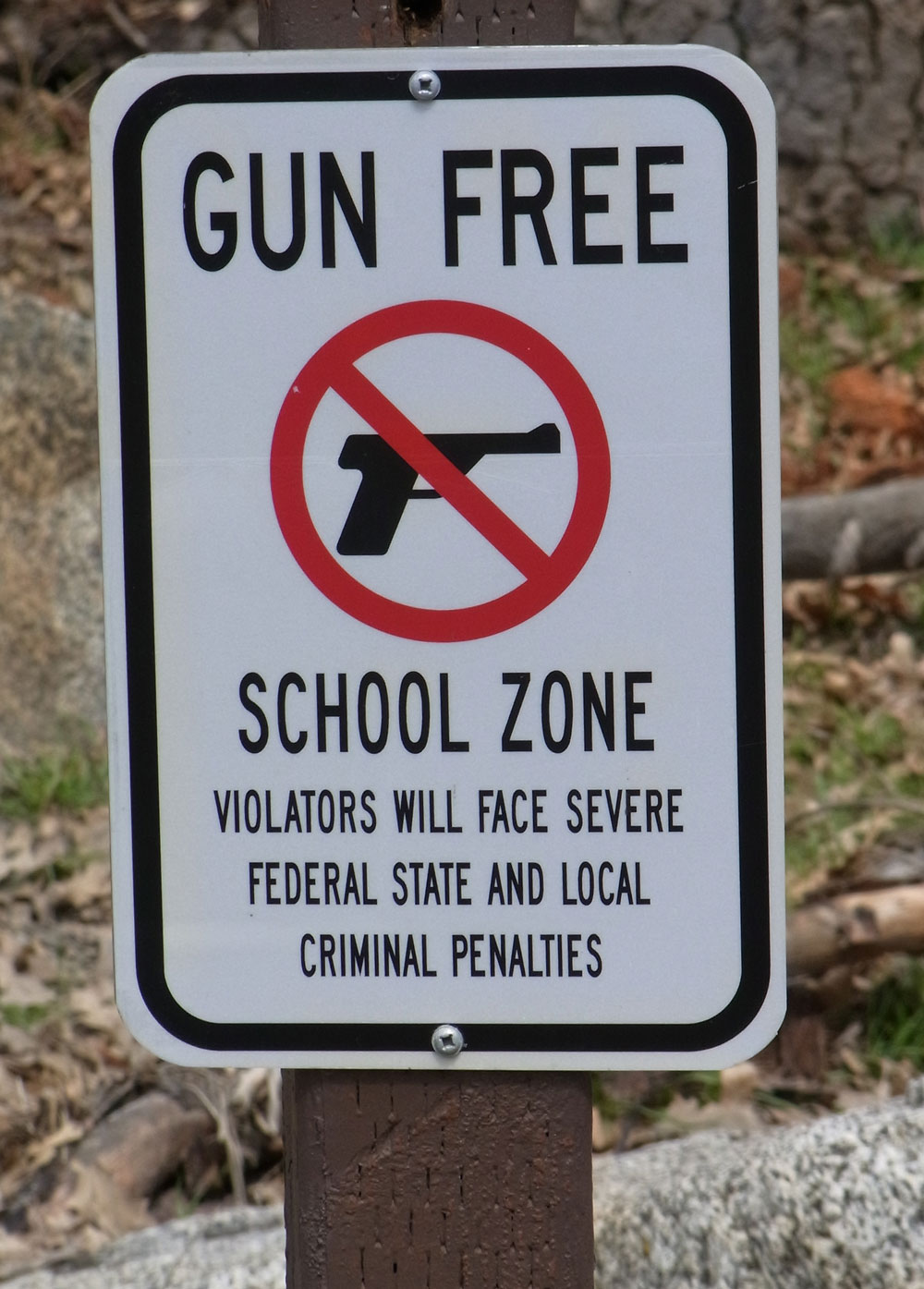
Image Credit: Flickr User – Like_the_grand_canyon
U.S. Congress passes act that removes individual discretion in deciding punishment for students who bring guns to school. Noncompliant schools lose federal education funding; leads to mandatory suspensions for minor infractions such as personal appearance, despite express instruction to punish only the most dangerous student behavior. Ushers in era of “zero tolerance.”
Missouri Supreme Court case prompted by articles on teen pregnancy and divorce removed from the school newspaper. Affirms “[t]he rights of students inside public schools are not as strong as the rights of adults,” and permits school officials to censor student speech “inconsistent with its basic educational mission,” even if the government could not censor said speech outside school.
Learn more
United States Courts: Facts and Case Summary – Hazelwood v. Kuhlmeier
“School officials have a responsibility to inculcate values and may prohibit student speech before student assembly that is vulgar, lewd, or plainly offensive”
Learn more
Matthew Fraser Speaks Out On 15 Year Old Supreme Court Free Speech Decision
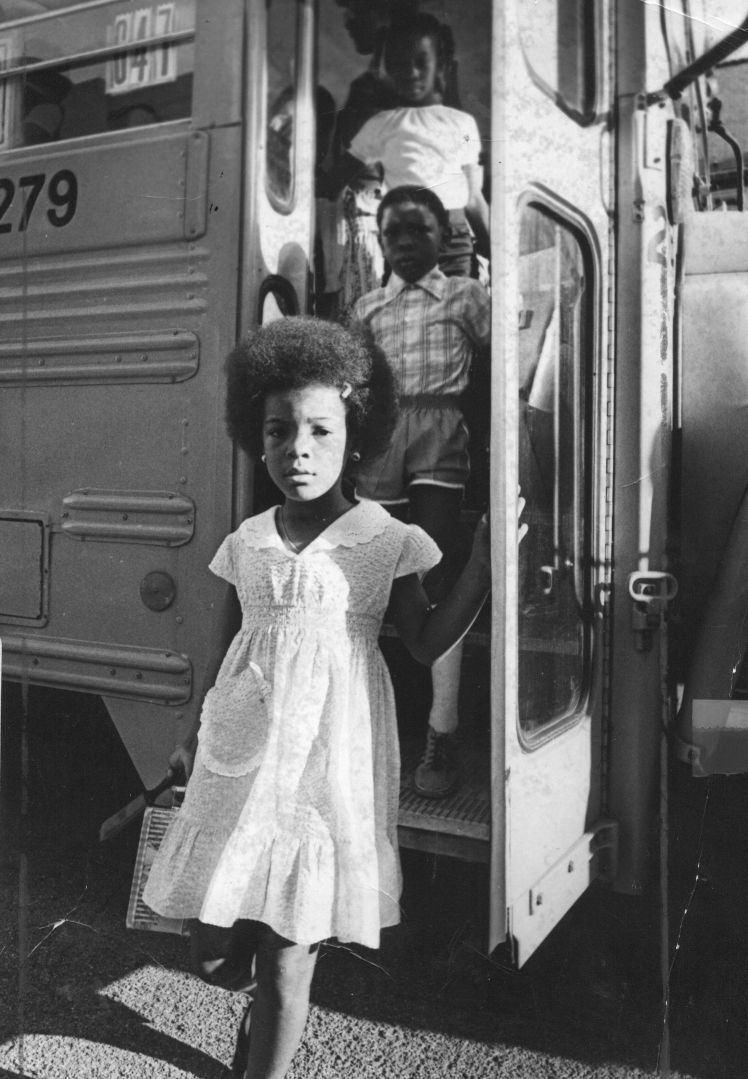
Image Credit: Sam Leone/Post-Dispatch
Prompted by 1972 Liddell ruling, “busing” (officially, interdistrict transfer) begins in St. Louis. Overseen by Voluntary Interdistrict Coordinating Council (VICC), participation peaks at more than 14,000 in 1999.
Learn more
Supreme Court decision establishes “due process” for students facing 10 or fewer days’ suspension. Students must be “given notice and afforded some kind of hearing,” and misconduct must be documented and reported to student’s guardian. Student can refute an allegation and request a hearing, but school not obligated to comply.
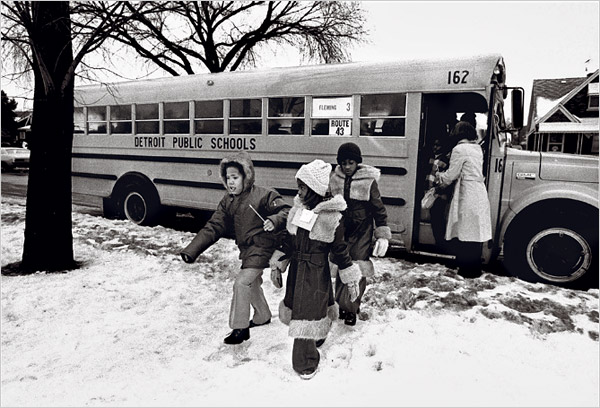
Image Credit: Associated Press
NAACP sues State of Michigan to desegregate Detroit’s schools through solution involving both city and suburbs. Supreme Court overturns lower court ruling, deeming no obligation to desegregate schools without proof of racist intent, permitting “de facto” segregation.
Five black families argue financial and physical resources distributed unequally to St. Louis public schools with race as clearly identifiable factor. Court finds State of Missouri responsible for maintaining school segregation and orders implementation of formal desegregation plan.
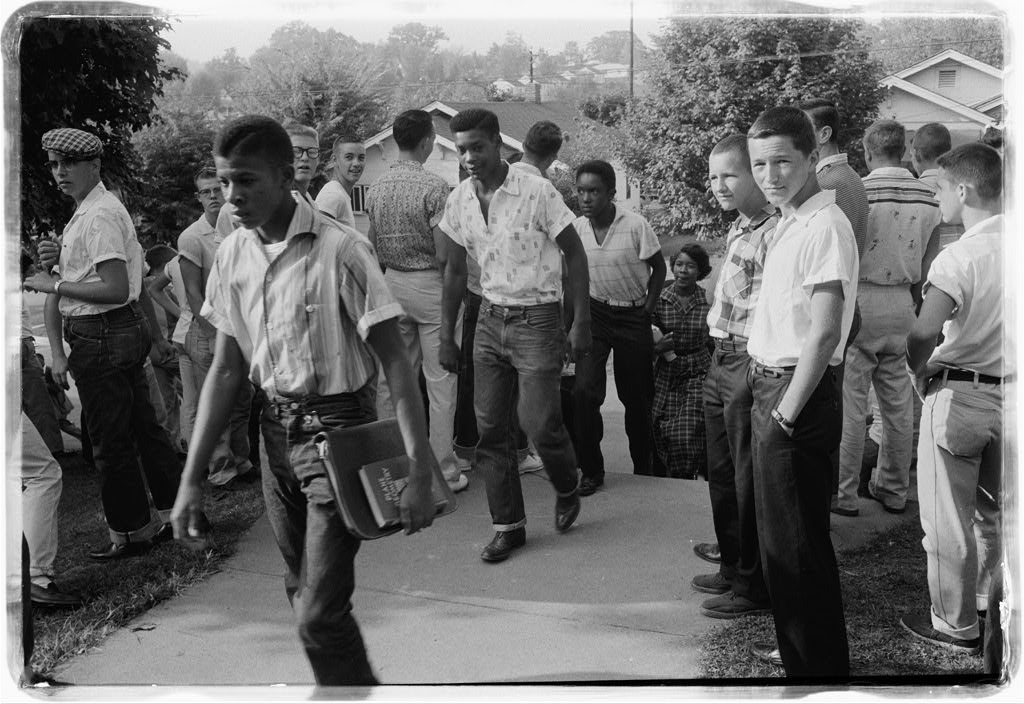
Image Credit: Library of Congress
Citing inadequacy of “all deliberate speed” in Brown v. Board ruling ordering schools to desegregate, Supreme Court orders immediate termination of segregated school systems.
Learn more
Justia: Alexander v. Holmes County Bd. of Ed., 396 U.S. 1218 (1969)
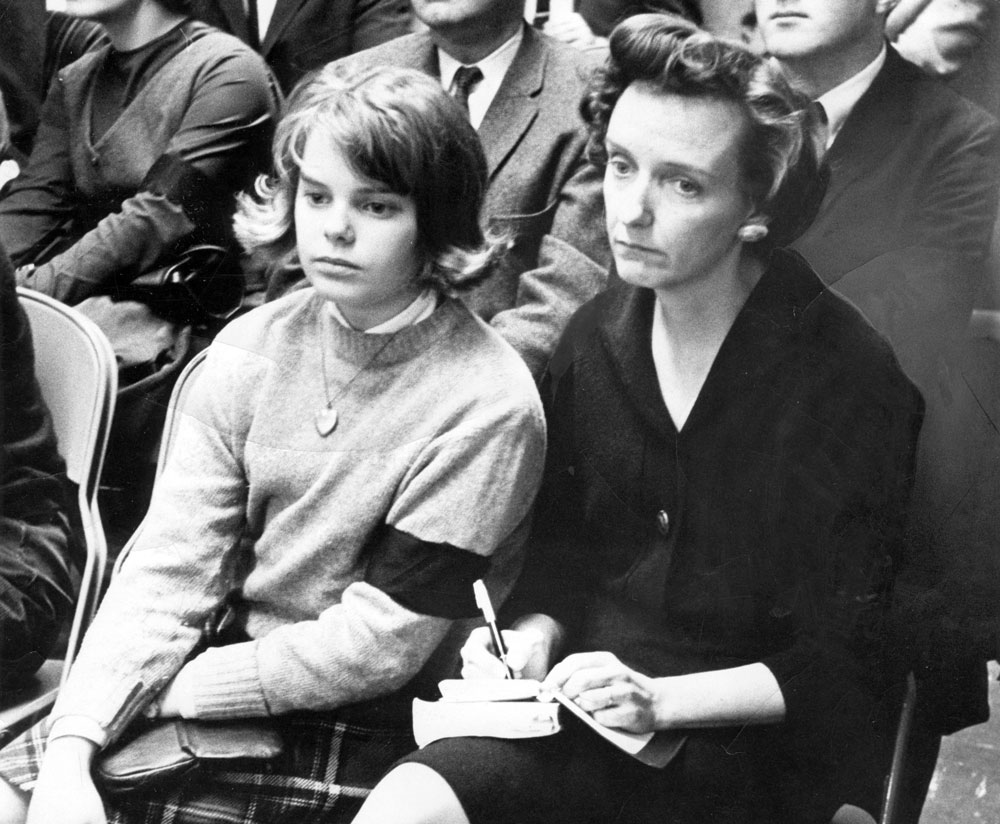
Image Credit: Resources For History Teachers
Brought about by students’ wearing armbands to protest the Vietnam War, this ruling asserted student First Amendment (free speech) rights in school. School officials have discretion to censor student speech “reasonably expected to cause substantial disruption or material interference with school activities.”
Learn more
Encyclopedia Britannica: Tinker v. Des Moines Independent Community School District
Supreme Court rules unanimously that racial segregation of children in public schools violates Equal Protection Clause of Fourteenth Amendment. The following year, SCOTUS orders desegregation be implemented with “all deliberate speed.”
Prompted by a law barring Black people from purchasing homes in White-only Missouri neighborhoods, Supreme Court rules racially restrictive home covenants unconstitutional.
Learn more
Shelley v. Kraemer: Legal reform for America’s neighborhoods
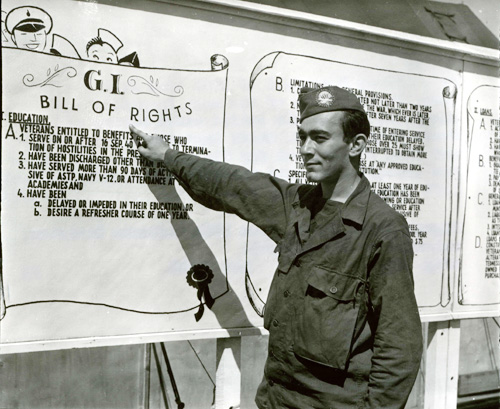
Image Credit: National Archives of the Unites States
Provided World War II veterans funds for college education, unemployment insurance, and housing. Federal Housing Agency racial exclusion programs put housing benefits out of reach of Black veterans.
Learn more
NPR: A ‘Forgotten History’ Of How The U.S. Government Segregated America

Image Credit: Arthur S. Siegel [Public domain], via Wikimedia Commons
St. Louis realtors’ association prompts referendum, which passed by voters at a 3-to-1 margin, to prevent Blacks from owning property in predominantly White neighborhoods. Supreme Court overturns similar ordinance next year, but industry-sanctioned housing discrimination persists.

Image Credit: John T. McCutcheon. Published in McCutcheon’s book The Mysterious Stranger and other Cartoons (1905). Online, courtesy Google Books.
Supreme Court rules 1890 Louisiana law “providing for separate railway carriages for the white and colored races” constitutional, sets stage for Jim Crow (“separate but equal”) laws. Plessy v. Ferguson gives “constitutional nod” to racial segregation in public places until 1950s.

Image Credit: National Archives of the Unites States ([1]) [Public domain], via Wikimedia Commons
Formally abolishes slavery, declares “[n]either slavery nor involuntary servitude, except as a punishment for crime whereof the party shall have been duly convicted, shall exist within the United States, or any place subject to their jurisdiction.”

Image Credit: Abraham Lincoln, digital reproduction by George Chriss (GChriss). With prior publication, the Emancipation Proclamation became effective 1 January 1863. [Public domain], from Wikimedia Commons
Issued by President Abraham Lincoln, the proclamation declared “all persons held as slaves” within rebellious areas “are, and henceforward shall be free.” The military (vs. humanitarian) measure changes character of the war; its acceptance of Black men into the Union Army and Navy results in nearly 200,000 Black soldiers and sailors fighting for Union and freedom by war’s end.
Supreme Court rules that “a negro, whose ancestors were imported into [the U.S.], and sold as slaves,” is not an American citizen whether slave or free, and cannot sue in federal court. Decision also protects slave owners’ Fifth Amendment rights, as slaves are categorized as property.
Congress grants Missouri’s request to be admitted to the union as a slave state. Official boundary drawn between free and slave states that persists until 1854. Missouri’s first constitution provides for creation of public schools, for white children.